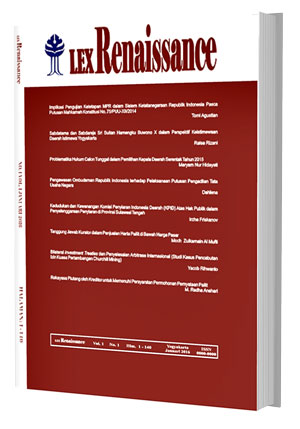Main Article Content
Abstract
Presently, Indonesia has a tendency to execute over-criminalization. One of which is in the settlement of legal cases over Law Number 19 of 2016 on Amendments to Law Number 11 of 2008 on Information and Electronic Transactions (ITE Law) which prioritizes criminal sanctions. Whereas in its content, the Law provides administrative sanctions, so that the ultimum remidium must be carried out by law enforcement officials. The author formulates two problems, namely first, what is the restotative justice model at the level of investigation, prosecution, and trial?; second, how is the reconceptualization of the application of restorative justice to the perpetrators and victims of the ITE Law? The research method used is a normative juridical method with a statutory and conceptual approaches and uses secondary data sources, in the form of primary, secondary, and tertiary legal materials. The results of this study conclude that first, at the level of restorative justice through material and formal investigations, the level of prosecution through the peaceful means and efforts by paying attention to the court supporting devices. Second, while at the trial level through law enforcement officers who are able to sort out and support efforts on restorative justice to produce a fair legal decisions. Second, reconceptualization of restorative justice in law enforcement of the ITE Law is through concepts of moro, dats and virtual justice.
Key Words: Criminalization; ITE law; restorative justice
Abstrak
Dewasa ini, Indonesia mengalami kecenderungan over kriminalisasi. Salah satunya terdapat dalam penyelesaian kasus hukum atas Undang-Undang Nomor 19 Tahun 2016 tentang Perubahan Atas Undang-Undang Nomor 11 Tahun 2008 tentang Informasi dan Transaksi Elektronik (UU ITE) yang lebih mengedepankan sanksi pidana. Padahal dalam muatannya, UU ini mengandung sanksi administratif, sehingga ultimum remidium harus dilakukan oleh aparat penegak hukum. Penulis merumuskan dua masalah, yaitu pertama, bagaimanakah model restotative justice pada tingkat penyidikan, penuntutan, dan pengadilan?; kedua, bagaimanakah rekonseptualisasi terhadap penerapan restorative justice pada pelaku dan korban tindak pidana UU ITE?. Metode penelian yang digunakan adalah metode yuridis normatif dengan pendekatan peraturan perundang-undangan dan konseptual serta menggunakan sumber data sekunder, berupa bahan hukum primer, sekunder, dan tersier. Hasil dari penelitian ini menyimpulkan bahwa pertama, di tingkat penyidikan restorative justice melalui materiil dan formil, tingkat penuntutan melalui proses dan upaya perdamaian dengan memperhatikan perangkat pendukung sidang. Kedua, tingkat pengadilan melalui aparat penegak hukum yang dapat memilah dan mendukung dalam upaya restorative justice, sehingga menghasilkan putusan hukum yang berkeadilan. Kedua, rekonseptual restorative justice dalam penegakan hukum UU ITE melalui moro konsep, dats konsep, dan virtual justice consept.
Kata Kunci: Pemidanaan; UU ITE; restorative justice
Keywords
Article Details
Authors who publish with this journal agree to the following terms:
a. Authors retain copyright and grant the journal right of first publication with the work simultaneously licensed under a Creative Commons Attribution License that allows others to share the work with an acknowledgement of the work's authorship and initial publication in this journal.
b. Authors are able to enter into separate, additional contractual arrangements for the non-exclusive distribution of the journal's published version of the work (e.g., post it to an institutional repository or publish it in a book), with an acknowledgement of its initial publication in this journal.
c. Authors are permitted and encouraged to post their work online (e.g., in institutional repositories or on their website) prior to and during the submission process, as it can lead to productive exchanges, as well as earlier and greater citation of published work (See The Effect of Open Access).References
- Buku
- Ali, Mahrus, Dasar-Dasar Hukum Pidana, Cetakkan Keempat, Sinar Grafika, Jakarta, 2017.
- Purba, Jonlar, Penegakkan Hukum Terhadap Tindak Pidana Bermotif Ringan Dengan Restorative Justice, Cetakkan Pertama, Jala Permata Aksara, Jakarta 2017.
- Tridiatno, Agus dan Yoachim, Keadilan Restoratif, Cetakkan Kelima, Cahaya Atma Pustaka, Yogyakarta, 2019.
- Jurnal
- Febby Mutiara Nelson, “Due Process Model dan Restorative Justice Di Indonesia: Suatu Telaah Konseptual“, Jurnal Hukum Pidana & Kriminologi, Volume 1, No. 1 Oktober 2020.
- Hanafi Arief dan Ningrum Ambarsari, “Penerapan Prinsip Restorative Justice dalam Sistem Peradilan Pidana di Indonesia”, Jurnal Al’Adl, Volume X Nomor 2, Juli 2018.
- Mahrus Ali, “Overcriminalization dalam Perundang-Undangan di Indonesia”, Jurnal Hukum Ius Quia Iustum, Vol. 25, No. 3, 2018.
- Peraturan Perundang-Undangan
- Undang-Undang Nomor 8 Tahun 1981 tentang Kitab Undang-Undang Hukum Acara Pidana (KUHAP)
- Undang-Undang Nomor 19 Tahun 2016 tentang Perubahan Atas Undang-Undang Nomor 11 Tahun 2008 tentang Informasi dan Transaksi Elektronik
- Lampiran Surat Keputusan Direktur Jendral Badan Peradilan Umum Nomor 1691/DJU/SK/PS.00/12/2020, 22 desember 2020 tentang Pedoman Penerapan Restorative Justice di Lingkungan Peradilan Umum
- Surat Edaran (SE)/8/VII/2018 tentang Pedoman Penerapan Keadilan Restoratif Dalam Penyelesaian Perkara Pidana
- Peraturan Jaksa Agung Nomor 15 Tahun 2020 tentang Penghentian Penuntutan Berdasarkan Keadilan Restorative Justice
- Media Elektronik
- Detik.com, https://news.detik.com/berita/d-5374503/ditjen-pas-warga-binaan-252384-orang-kapasitas-lapas-rutan-hanya-135704.
References
Buku
Ali, Mahrus, Dasar-Dasar Hukum Pidana, Cetakkan Keempat, Sinar Grafika, Jakarta, 2017.
Purba, Jonlar, Penegakkan Hukum Terhadap Tindak Pidana Bermotif Ringan Dengan Restorative Justice, Cetakkan Pertama, Jala Permata Aksara, Jakarta 2017.
Tridiatno, Agus dan Yoachim, Keadilan Restoratif, Cetakkan Kelima, Cahaya Atma Pustaka, Yogyakarta, 2019.
Jurnal
Febby Mutiara Nelson, “Due Process Model dan Restorative Justice Di Indonesia: Suatu Telaah Konseptual“, Jurnal Hukum Pidana & Kriminologi, Volume 1, No. 1 Oktober 2020.
Hanafi Arief dan Ningrum Ambarsari, “Penerapan Prinsip Restorative Justice dalam Sistem Peradilan Pidana di Indonesia”, Jurnal Al’Adl, Volume X Nomor 2, Juli 2018.
Mahrus Ali, “Overcriminalization dalam Perundang-Undangan di Indonesia”, Jurnal Hukum Ius Quia Iustum, Vol. 25, No. 3, 2018.
Peraturan Perundang-Undangan
Undang-Undang Nomor 8 Tahun 1981 tentang Kitab Undang-Undang Hukum Acara Pidana (KUHAP)
Undang-Undang Nomor 19 Tahun 2016 tentang Perubahan Atas Undang-Undang Nomor 11 Tahun 2008 tentang Informasi dan Transaksi Elektronik
Lampiran Surat Keputusan Direktur Jendral Badan Peradilan Umum Nomor 1691/DJU/SK/PS.00/12/2020, 22 desember 2020 tentang Pedoman Penerapan Restorative Justice di Lingkungan Peradilan Umum
Surat Edaran (SE)/8/VII/2018 tentang Pedoman Penerapan Keadilan Restoratif Dalam Penyelesaian Perkara Pidana
Peraturan Jaksa Agung Nomor 15 Tahun 2020 tentang Penghentian Penuntutan Berdasarkan Keadilan Restorative Justice
Media Elektronik




